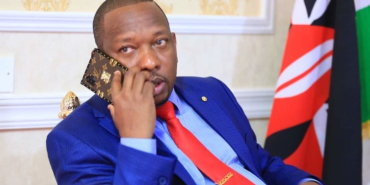Sh890m Allocated to State House for Renovations

Ongoing renovations to State House Nairobi are generating public debate in Kenya, amid concerns about governance, priorities, and accountability as the works enter their third year.
The timing of the refurbishment, costing nearly a billion shillings, coincides with a broad government austerity programme designed to tackle rising national debt and tightened public spending. Budget estimates from the National Treasury indicate Sh894.9 million allocated for the rehabilitation and maintenance of State House Nairobi and other official residences for the 2025/2026 financial year. Of this, Sh680.7 million is specifically for renovations at the Nairobi site. Additional funds are designated for lodges in Eldoret, Sagana, Mombasa, Nakuru, Kisumu, Kakamega, and Kisii, as well as a mechanical garage, demonstrating a consistent pattern of investment in presidential facilities.
Since assuming office in 2022, President William Ruto's administration has implemented measures to scale back subsidies, increase taxes, and slash ministry budgets to stabilise the economy. The contrast between these measures and the expenditure on State House renovations is sparking public scrutiny. The Treasury defends the spending as essential for enabling the President to fulfil his constitutional mandate.
Official documents describe State House as a centre for executive leadership and coordination, framing its upkeep as both symbolic and functional. Public sentiment, however, reflects disillusionment with perceived elite privilege amid rising economic hardship. Critics contend that these budgetary priorities undermine the government's commitment to austerity. Kisumu West MP Rozaah Buyu has criticised the spending, saying, "If Kenyans are suffering because of budget cuts, the State House should take the lead in tightening its belt."
Opposition to the renovations, including structural alterations such as flattening the historical roofline, is also evident. The Architectural Association of Kenya has voiced aesthetic objections to the changes. These sentiments intensified following widespread youth-led protests against the now-aborted Finance Bill 2024, which proposed new tax hikes. While the administration has retracted those taxes, concerns about fiscal discipline remain, particularly given the continued allocation of funds to presidential residences.
President Ruto is not the first head of state to undertake significant renovations at the seat of power. His predecessor, President Uhuru Kenyatta, allocated over Sh10.7 billion to infrastructure and property upgrades during the latter part of his tenure, including extensive work at Sagana Lodge. However, the current administration's persistent investment in improvements is raising questions about timing and necessity. Lawyer and activist Joshua Okayo articulates a deeper unease shared by many Kenyans.
"State House renovations have become a channel to make money. They set aside the budget, do a little work to show something was done, and then steal the rest," he says.
Okayo advocates for legal action to challenge what he describes as "opulence" and a betrayal of the government's pledge to deliver a people-centred administration. Opacity surrounding the renovations compounds these allegations. State House Comptroller Katoo ole Metito has informed Members of Parliament that certain renovation costs are managed through the National Intelligence Service and the Ministry of Defence, citing security protocols.
While security concerns may be legitimate, this arrangement limits public oversight and contributes to suspicions about financial propriety. Governance expert Javas Bigambo argues that presidential residences are cultural artefacts representing the identity and dignity of the republic.
"There's symbolism attached to State House," he explains. "It's the ultimate seat of power. Beyond the authority of the office, it must also reflect honour."
He cautions that continued investments in luxury upgrades risk shifting the symbol from national honour to elite indulgence. Bigambo contends that if renovations are to be accepted in consecutive financial years, the government must provide compelling evidence of necessity.
"For two consecutive years of renovations to be justified, there should have been a clear valuation demonstrating the need, whether it's for structural integrity, sewer systems, or even cosmetic upkeep," he says.
In a country where public hospitals and schools often lack basic facilities, multimillion-shilling allocations to maintain presidential lodges paint a picture of potentially skewed priorities. Public scepticism intensified in 2024 when a Sh1.5 billion allocation for renovations was withdrawn during a supplementary budget process, only to re-emerge in the 2025/2026 proposals with renewed vigour. The reduced figure of Sh894.9 million still represents a significant commitment, particularly when set against demands for more urgent investment in citizen welfare.
Adding to the complexity, State House Nairobi's architectural history dates back over a century, originally constructed as the residence for the colonial governor of British East Africa. The building has since housed every Kenyan President. Before Ruto's administration, its structural integrity had reportedly declined, with independent assessments recommending either renovation or reconstruction.








Comments
Hii ni ishara moja ya…
Permalink
Hii ni ishara moja ya uporaji wa mali ya umma. Kwa nini Ndugu yetu Samoei Cherop Ruto anataka kupoteza pesa za umma na huku baada ya miaka miwili, atarudishwa Sugoi baada ya kupoteza uchaguzi 2027?
Ishara nyingine ni utumiaji wa magari ya umma kwa njia mbya kwa kuzururazurura nchini na huku ana afisi yake kwenye Jumba la Harambee!
Add new comment